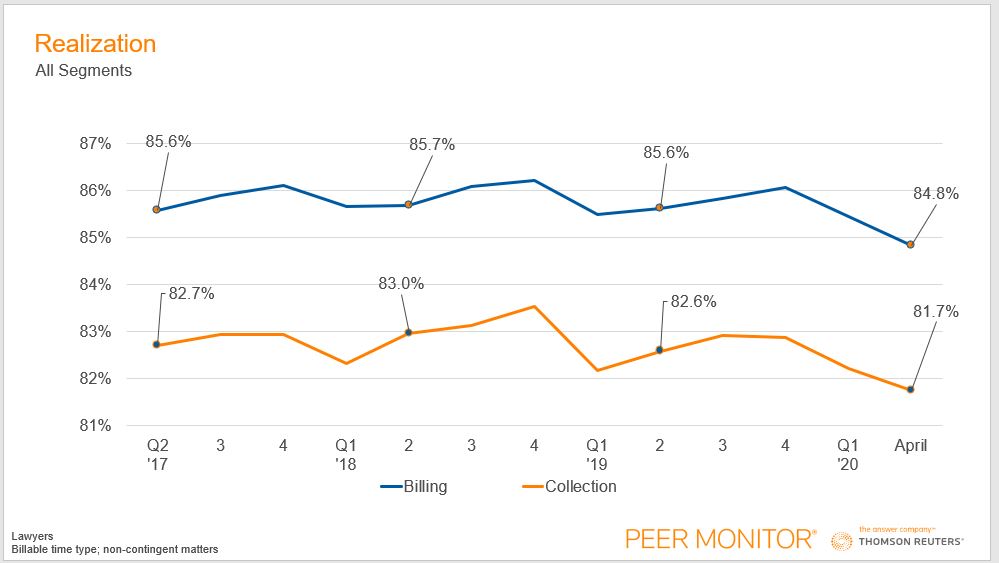In the current pandemic, "free-for-all" isn’t really a good billing strategy, but that's often the default position for a law firm without a guiding vision
I’ve written recently about the need to be cautious about how your law firm approaches discounts to clients in crisis. The same pricing leaders from the Legal Value Network (LVN) who inspired that post had more to share about the broader topic of law firm strategy in a crisis that I thought was worth highlighting on its own.
Free-for-all isn’t really a strategy, but that is the default position for a law firm that finds itself in the midst of a crisis with no guiding strategic vision. As a result, lawyers with the best of intentions trying to do what is right for their clients may well end up giving away the farm… or the firm. We’re already seeing some effects of this even early in the pandemic as reflected in declines in firms’ realization rate.
The general gut reaction of many would be to assume that realizations would decline during this time as clients quickly clamp down on expenditures, and this has no doubt been happening. However, a look deeper into the data shows a more nuanced story. Examining the last three years of data, for example, shows there has been a fairly consistent gap of around 3 percentage points between billing realization (the percentage of standard rate billed to a client) and collected realization (the percentage of standard rate realized as collections from the client).
As we look at the downturn in April of this year, one of the first things to notice is that the gap between billed and collected realization has not widened noticeably, if at all. Collected realization has fallen to 81.7%, but that’s still only about 3 percentage points below the billed realization rate of 84.8%. So, what’s happening? Most likely, lawyers are rushing to provide fee relief to clients. But without a strategic approach as to how to handle such relief, there is no way for a firm to ensure that the relief provided is appropriate or does not undercut other firm priorities.

To be successful, a law firm must be guided by a clear strategy that acknowledges, weighs, and balances often competing priorities. Billing is but one of those priorities, but it is vital because it is the source of the funding the enables many of the others.
The pricing leaders within with whom I spoke offered a few suggestions for law firms dealing with this situation, such as:
1. Establish a centralized means to review partner billing requests — Centralizing the authority to review billing requests in a finance committee helps establish the means by which these requests can be approached strategically.
2. Set guard rails that require committee review — As a starting point, establish a policy that any variation from standard billing practices that is being sought due to the current crisis should trigger committee review. Beyond that, when establishing the guard rails for committee review, remember that when it comes to billing, what lawyers can do, they will do — so be prepared for whatever threshold you set for review to become the standard discount.
3. Keep the committee small — Don’t have too many cooks in the kitchen; for example, LVN members at even the largest law firms recommend no more than four to six members for the committee. Suggested roles include the Chief Financial Officer, representatives from the firm’s various regions or practices, and not necessarily just partners. Remember, it’s important to include people with the broader interests of the firm within their scope; and crucially, there must be at least one person on the committee who is hard to persuade.
4. Focus on collections — Cash is king, especially now, and law firms should be focusing on how to maximize their cash collections. This requires undertaking a holistic examination of where relief should be allowed, where payment terms should be changed, and where the firm should hold fast.
5. Balance the short-term and the long-term — In a crisis, it’s easy to revert to the hierarchy of needs, where the more foundational element of safety gain focus. But don’t lose sight of the long-term needs of your law firm’s business. Deferred investment in your firm, like deferred maintenance in your home or car, does not solve a problem. It saves some cash today, but may create an even larger expense later. These decisions are often necessary, but they should be undertaken intentionally.
Law firms are mounting ever greater efforts to refine their legal operations, streamline their processes, and improve their abilities. A key component of that is how firms’ own internal operations run. Even if your firm has not yet invested in pricing, project management, or legal operations more generally, now is a great time to start.
The importance of these roles is only going to grow. And working to establish more robust legal operations capabilities in today’s climate will allow for these functions to develop alongside their in-house counterparts, which in turn will allow firms to learn more about their clients’ pain points and develop more effective solutions for them.
Ultimately, the end goal of a law firm’s strategy in today’s environment should be to arrive at a targeted approach that leaves the firm in a better place in the future than where it stands today.






